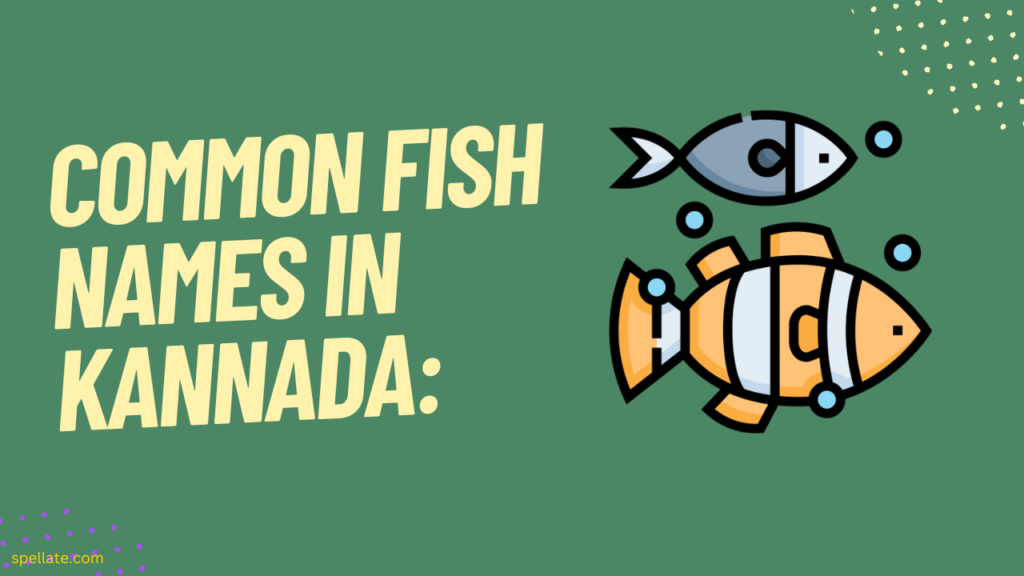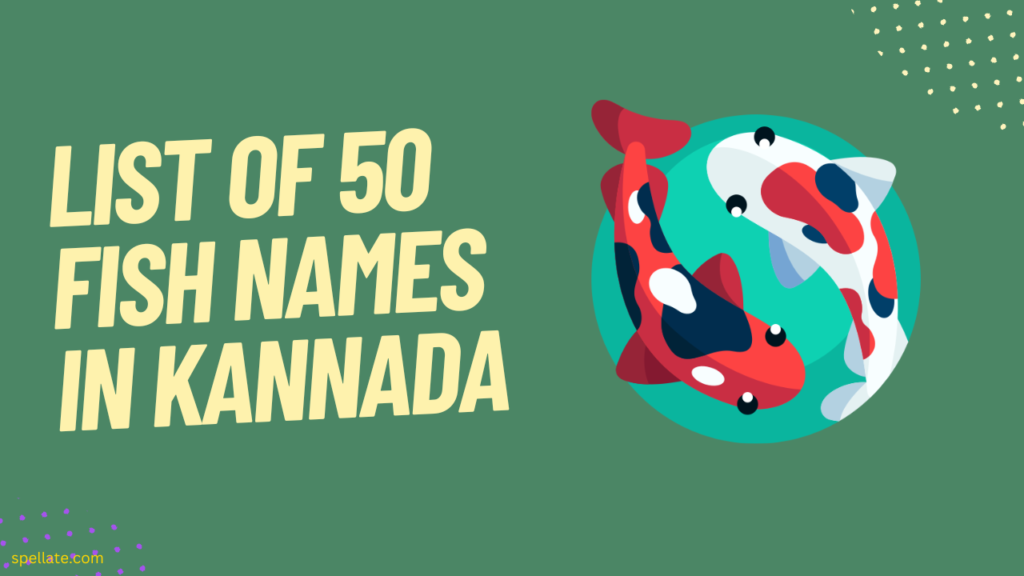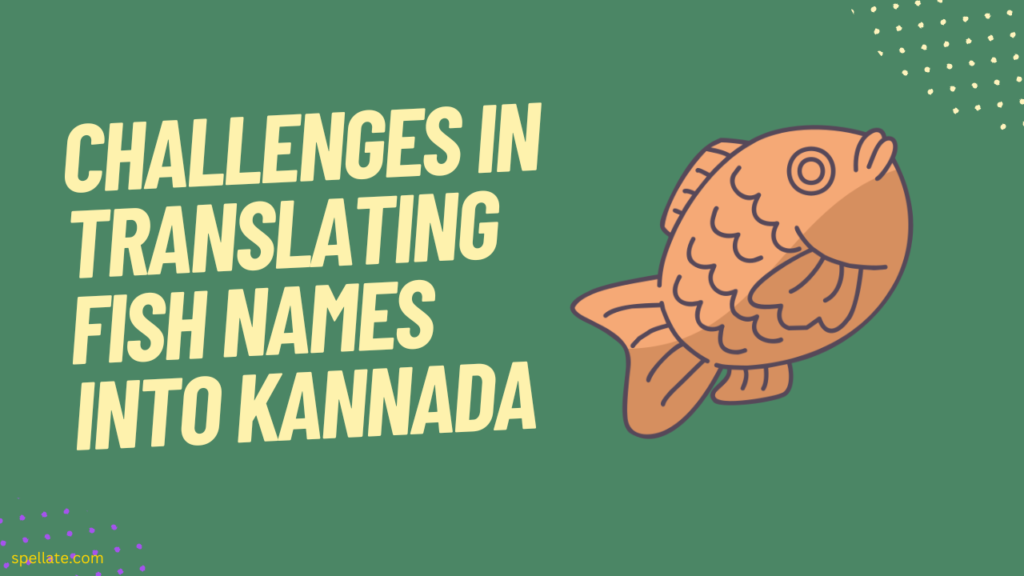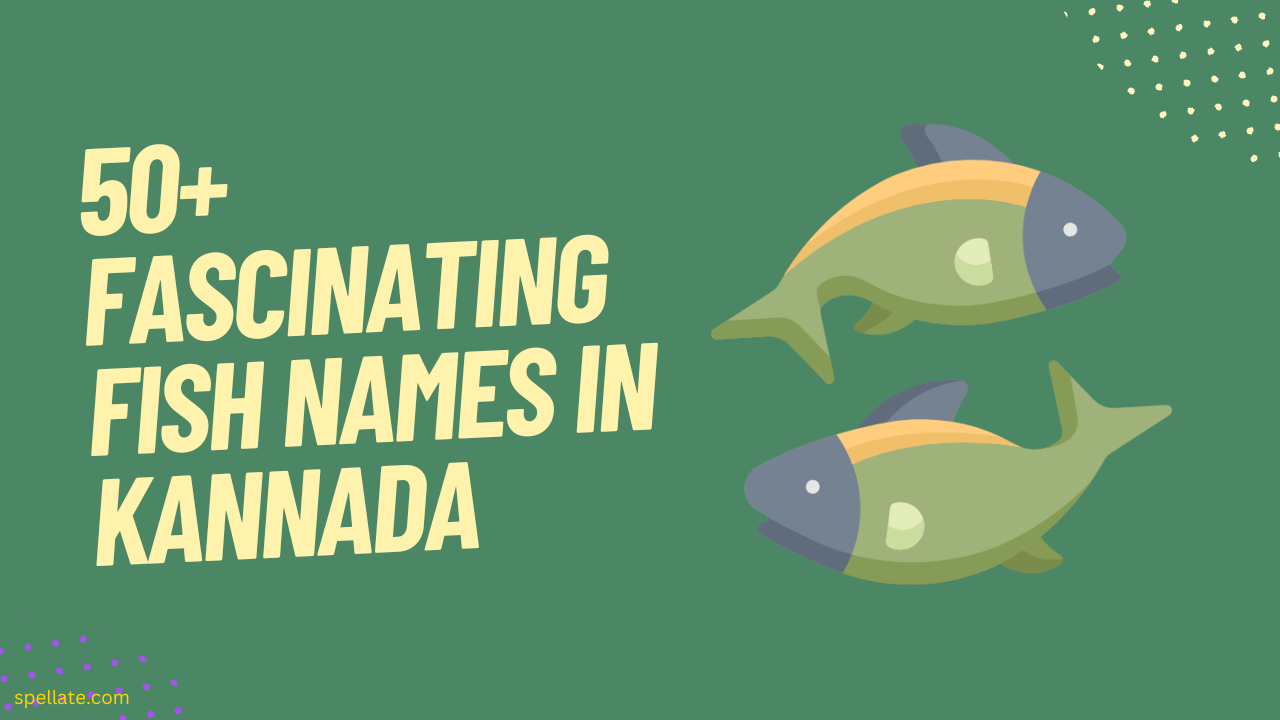Step into the vibrant world of aquatic diversity as we dive into the fascinating realm of fish names in Kannada. With over 300 species swimming through Karnataka’s waterways, each bearing its own unique name, this article serves as a gateway to unlock the secrets of these underwater creatures.
From the majestic Mahseer to the elusive Hilsa, and from the fiery Red Snapper to the mesmerizing Pearlspot, discover how these names not only reflect their physical attributes but also carry cultural significance and historical tales that have been woven into Karnataka’s rich tapestry. Join us on this journey where language meets marine life, revealing an awe-inspiring spectrum of fish names that will leave you captivated and yearning for more.
Common Fish Names in Kannada:

Kannada, a Dravidian language spoken in the southern part of India, has a rich vocabulary when it comes to naming fish. Fish are an integral part of Kannada cuisine, and learning their names can enhance your understanding of the local culture. Here are some common sea fish names in Kannada:
1. ಬಾಸ (Baasa) – Catfish:
The Kannada language has its own word for catfish – ಬಾಸ (Baasa). This particular species of fish stands out with its unique whisker-like barbels around the mouth, which bear an uncanny resemblance to a feline’s whiskers. In the culinary realm of Kannada, catfish holds great significance due to its exceptional taste and tender flesh.
It has become a favored ingredient in traditional recipes like (Baasa Saaru), an aromatic curry infused with an assortment of spices, coconut shavings, and tangy tamarind. The adaptability of catfish makes it suitable for diverse cooking techniques ranging from frying to stewing.
2. ಕಟ್ಟಿ (Katti) – Eel:
The Kannada word ಕಟ್ಟಿ (Katti) denotes a fascinating aquatic creature called an eel. Eels are remarkable fish with elongated bodies resembling snakes that thrive in both freshwater habitats and salty marine waters. Within the boundaries of Karnataka, these snake-like beings commonly inhabit rivers and streams. Known for their sleek and slimy skin, these slender fish possess a distinctive appearance that sets them apart from others in their underwater realm.
Although not as frequently consumed as some other types of fish found in this region, eels hold immense cultural significance among the local population. The preparation methods for these intriguing creatures often involve marinating them before frying or incorporating them into delectable curries bursting with flavors. Eel’s taste is truly one-of-a-kind, making it an indispensable component of the traditional culinary legacy cherished by those who speak Kannada.
3. ಮತ್ತಿ (Mattu) – Mullet:
The Kannada language employs the term ಮತ್ತಿ (Mattu) to denote mullet fish – a versatile aquatic creature inhabiting both freshwater and marine ecosystems. Distinguished by their slim physique and forked tail, these mullet specimens typically exhibit a silvery or greyish complexion. Within the boundaries of Kannada culture, mullet fish holds a special place due to its delicate flavor profile.
This delectable ingredient finds frequent application in curries, fries, and an assortment of gastronomic delights. Its compact size makes it an ideal choice when it comes to effortless cooking while allowing it to effortlessly soak up myriad spice blends and seasonings
4. ಕೊಂಬು (Kombu) – Shark:
The term ಕೊಂಬು (Kombu) corresponds to sharks in the Kannada language. Sharks are top-tier predators inhabiting marine ecosystems and exhibit an array of species and dimensions. Along the coastal areas of the Kannada region, shark meat plays an integral role in culinary customs as a customary dietary component.
Revered for its firm consistency and distinct taste profile, shark meat frequently stars in dishes such as (Kombu Ajadhe) – a fiery curry brimming with flavorsome spices, coconut essence, and delectable chunks of shark meat. However, it is imperative to acknowledge that specific shark species face endangerment; hence responsible fishing practices should be prioritized to conserve these remarkable creatures.
5. ಬೆಟ್ಟ (Betta) – Betta Fish:
“ಬೆಟ್ಟ” refers to Betta fish, which are also commonly known as Siamese fighting fish. Betta fish are popular ornamental fish known for their vibrant colors and elaborate fins. While they are not typically consumed as food in the Kannada region, they hold a special place in the aquarium hobbyist community.
Betta fish are often kept in decorative fish tanks due to their striking appearance and unique behaviors. Their territorial nature and beautiful displays of fin flaring make them a captivating addition to home aquariums.
6. ರೋಹು (Rohu) – Rohu Fish:
In Kannada, “ರೋಹು” refers to the Rohu fish, a commonly consumed freshwater fish. Rohu is popular in many regions of India, including the Kannada-speaking areas. It is known for its succulent flesh and is often used to make various traditional dishes.
One of the popular preparations is “ರೋಹು ಮೆಸು” (Rohu Mesu), a curry made with Rohu fish cooked in a spicy and tangy gravy. Due to its versatility and availability, Rohu is a staple ingredient in Kannada cuisine, contributing to the rich culinary heritage of the region.
7. ಕರಕ್ (Karak) – Crayfish:
“ಕರಕ್” refers to crayfish in Kannada. Crayfish are small, freshwater crustaceans resembling miniature lobsters. They are typically found in ponds, lakes, and slow-moving streams. In the Kannada region, crayfish are not as commonly consumed as some other types of seafood, but they hold cultural significance.
They are sometimes used in regional dishes or added to curries for flavor. While not as widespread in culinary use, crayfish contribute to the biodiversity of aquatic life in the region’s water bodies.
8. ನೆರಳು (Neralu) – Anchovy:
The word ನೆರಳು (Neralu) signifies anchovy in the Kannada language. Anchovies are petite fish with high oil content that are commonly utilized to impart strong flavor profiles in various culinary preparations. In Kannada cuisine, anchovies are particularly popular for concocting fish-based sauces and condiments that elevate the taste of traditional dishes.
They are often sun-dried or preserved to heighten their impact on gastronomic delights. Moreover, these flavorful fish can also be fried until crispy and enjoyed as a delectable snack option. Due to their intense and savory nature, they are greatly sought-after ingredients when it comes to enriching curries, rice dishes, and chutneys.
9. ಕೊರಮನೆ (Koramaney) – Sardine:
“ಕೊರಮನೆ” refers to sardines in Kannada. Sardines are small, oily fish that are rich in nutrients like omega-3 fatty acids. In the coastal regions of the Kannada-speaking areas, sardines are an important part of the diet due to their availability and nutritional value. They are often used in curries, fries, and pickles.
Sardines can also be dried and preserved, making them a staple that can be enjoyed even during non-fishing seasons. Sardines are appreciated for their robust flavor and are used in various preparations to add depth to the taste of traditional dishes.
You May Also Like
10. ಬಂಗಡೆ (Bangade) – Mackerel:
In the Kannada language, the word ಬಂಗಡೆ (Bangade) denotes mackerel fish, a variety known for its uniquely flavored meat and rich oil content. These fish are predominantly found in coastal waters and are highly valued as an essential component of the diet among residents of Kannada’s coastal regions.
Mackerels can be cooked using diverse techniques including grilling, frying, or preparing curries. One particularly favored recipe is called (Bangade Mesu), which entails a zesty curry infused with spices that perfectly complements the mackerel’s robust taste. The strong essence of mackerels makes them an ideal ingredient for creating extraordinary and appetizing dishes.
List of 50 fish names in Kannada

Kannada, the official language of Karnataka in South India, is known for its rich cultural heritage and vibrant linguistic diversity. In this section, we will explore a fascinating topic – 50 fish names in Kannada and English. Fish holds a significant place in the culinary traditions of Karnataka, and knowing their names would not only enhance your knowledge but also help you appreciate the local cuisine even more. Let’s dive into the list of 50 fish names in Kannada and English:
| No. | Kannada Fish Name | English Translation |
| 1 | ಮೀನು (Meenu) | Fish |
| 2 | ಬಾಸ (Baasa) | Catfish |
| 3 | ಕಟ್ಟಿ (Katti) | Eel |
| 4 | ಮತ್ತಿ (Mattu) | Mullet |
| 5 | ಕೊಂಬು (Kombu) | Shark |
| 6 | ಬೆಟ್ಟ (Betta) | Betta Fish |
| 7 | ರೋಹು (Rohu) | Rohu Fish |
| 8 | ಕರಕ್ (Karak) | Crayfish |
| 9 | ನೆರಳು (Neralu) | Anchovy |
| 10 | ಕೊರಮನೆ (Koramaney) | Sardine |
| 11 | ಬಂಗಡೆ (Bangade) | Mackerel |
| 12 | ಬಾಮಣಿ (Baamani) | Pearlspot Fish |
| 13 | ಹೊಳ್ಳಿ (Holli) | Hilsa Fish |
| 14 | ಮಸಿ (Masi) | Mullet |
| 15 | ನೆತ್ತುಗಾಲು (Nettugalu) | Threadfin Salmon |
| 16 | ಹುರುಳಿಮೀನು (Hurulimeenu) | Indian Mackerel |
| 17 | ಜಿಲೇಬಿ (Jilebi) | Ribbon Fish |
| 18 | ಅವಲ (Avala) | Indian Sardine |
| 19 | ಕೊಡದಿ (Kodadi) | Squid |
| 20 | ಸಾರ್ಡೀನ್ (Saardeen) | Sardine |
| 21 | ಬೋಮನೆ (Bomaney) | Tuna Fish |
| 22 | ಬಾರಾ (Baara) | Barracuda |
| 23 | ಕರ್ಕೊಳೆ (Karkole) | Grouper |
| 24 | ನೆಲ್ಲೆ (Nelle) | Threadfin Bream |
| 25 | ಅವಲಿ (Avali) | Ribbon Fish |
| 26 | ಗೊಂಗ (Gonga) | Catla Fish |
| 27 | ಕೊಬ್ಬರಿ (Kobbari) | Coconut Milk Shark |
| 28 | ಬಾಮ್ (Baam) | Tuna Fish |
| 29 | ಕೊಮನಿ (Komaney) | Emperor Fish |
| 30 | ಮುಕ್ಕ (Mukka) | Barracuda |
| 31 | ನೀಲಿ (Neeli) | Bluefin Trevally |
| 32 | ಕಾಲ ಮೀನ್ (Kaala Meen) | Salmon |
| 33 | ಮುಗಿಲು (Mugilu) | Grey Mullet |
| 34 | ತಿಲಪಿಯಾ (Tilapiya) | Tilapia |
| 35 | ಸುರೈಮೀನು (Surimeenu) | Snakehead Murrel |
| 36 | ಅರಮಿ (Arami) | Golden Anchovy |
| 37 | ಪೊಟಿ (Poti) | Mullet |
| 38 | ಚಂದ್ರಕಾಂತ (Chandrakanta) | Moonfish |
| 39 | ಅಕುಪ (Akupa) | Red Snapper |
| 40 | ಚೇಪ (Chepa) | Catfish |
| 41 | ನೀಲಾಮೀನು (Neelameenu) | Blue Catfish |
| 42 | ಕುಂದೆ (Kunde) | Perch |
| 43 | ಹಳ್ಳಿಮೀನು (Hallimeenu) | Tilapia |
| 44 | ಕಾಂಕಂತ (Kankant) | Sillago |
| 45 | ಕುರವ (Kurava) | Sole Fish |
| 46 | ಕೋಳಿ (Koli) | Clam |
| 47 | ಎಲ್ಲೆ (Elle) | Sardine |
| 48 | ನಂದಕ (Nandaka) | Butterfish |
| 49 | ಸಹಸ್ರಕಡಿ (Sahasrakadi) | Spadefish |
| 50 | ತಿಲ್ಲಿ (Tilli) | Herring |
Importance of Kannada fish names
The importance of Kannada fish names goes beyond just knowing how to identify different species of fish. It is a way to preserve and celebrate the rich cultural heritage and biodiversity of Karnataka. Each fish name in Kannada tells a story, often reflecting the characteristics or habitat of the fish.
Furthermore, knowing fish names in Kannada helps promote sustainable fishing practices. By using local language names, fishermen and consumers can better understand which species are endangered or overfished. This knowledge empowers individuals to make informed choices about their seafood consumption and support conservation efforts.
Moreover, fish names in Kannada play a crucial role in promoting regional cuisine and culinary traditions. They help connect people with their food heritage by allowing them to explore traditional recipes that have been passed down through generations.
Challenges in translating fish names into Kannada

Translating fish names in Kannada can present certain challenges due to linguistic, cultural, and biological factors. Here are some of the challenges that may arise when translating fish names:
Cultural Context: Many fish species have distinct local names that might not have direct equivalents in Kannada. Translating these names while preserving their cultural significance and regional context can be challenging. Different regions may have their own names for the same fish species, making it important to capture the diversity of local knowledge.
Scientific Nomenclature: Fish species are often identified by their scientific names, which are based on Latin taxonomy. Translating these scientific names into Kannada while maintaining accuracy can be complex, especially since certain scientific names may not have direct linguistic equivalents.
Language Variations: Kannada is spoken across different regions, and there can be variations in pronunciation, vocabulary, and terminology. Translating fish names in a way that is universally understood by Kannada speakers from different areas requires careful consideration.
Multiple Meanings: Some Kannada words may have multiple meanings, leading to confusion when translating fish names. Finding the appropriate context to ensure accurate translation is essential to avoid misunderstandings.
Missing Equivalents: Not all fish species found in other regions or languages have direct counterparts in Kannada. This can lead to challenges in finding appropriate translations, especially for less common or foreign species.
Cultural Perception: Fish names might carry specific cultural connotations that don’t translate directly. Ensuring that the translated name captures the essence of the original name in terms of cultural perceptions and culinary significance can be challenging.
Rapid Change: In a rapidly changing world, new fish species may be discovered, and their names might need to be translated accurately into Kannada. Keeping up with these changes and maintaining an updated fish name database can be demanding.
Ecological and Biological Differences: Fish species may have different ecological distributions and biological characteristics in different regions. Translating fish names without accounting for these differences might lead to misidentification or confusion.
Local Knowledge: Some fish species might be known by specific local names that are not widely recognized. Translating these names accurately requires consultation with local experts and communities.
Final Thoughts
In conclusion, learning the names of fish in Kannada can be a fascinating journey into the rich cultural and linguistic heritage of Karnataka. By familiarizing ourselves with these names, we not only gain a deeper appreciation for the biodiversity of our water bodies but also contribute to the preservation of local languages.
Whether you are an angler, a nature enthusiast, or simply curious about language and culture, taking the time to explore sea fish names in Kannada is certainly worth it. So why not dive into this linguistic adventure and discover the beauty and diversity of fish species right in your own backyard? Start today and expand your knowledge while connecting with the natural world around you.
FAQs
How do I pronounce the word fish in Kannada?
The word fish is pronounced as meenu in Kannada.
What are some fatty fish names in Kannada
Some fatty fish names in Kannada include “ಬಂಗಡೆ” (Bangade) which is Mackerel, “ಎಲ್ಲೆ” (Elle) which is Sardine, and “ಸುರೈಮೀನು” (Surimeenu) which is Snakehead Murrel.
What are some fish pet names in kannada
Fish pet names in Kannada are often simple and affectionate. Common pet names include “ಮೀನು” (Meenu), “ಬಾಸ” (Baasa), and “ಮತ್ತಿ” (Mattu), which correspond to generic terms for fish, catfish, and eel, respectively.
